Research on Slope Excavation Stability Based on PSO-BP Reinforcement Optimization Algorithm
Abstract
1. Introduction
2. Introduction to Slope
2.1. Topography
2.2. Acquisition of Rock Mechanics Parameters of Slope
2.2.1. Sample Acquisition
2.2.2. Sample Preparation
2.2.3. Test Scheme
2.2.4. Test Results
3. Slope Stability Analysis
3.1. Analysis of Initial Ground Stress
3.2. Slope Excavation Stability Analysis
3.2.1. Stress Analysis
3.2.2. Excavation Displacement Analysis
3.2.3. Analysis of Plastic Zone and Maximum Shear Strain
3.2.4. Analysis of Slope Dissipation Energy
3.2.5. Slope Safety Factor Analysis
4. Prediction of Slope Reinforcement Parameters Based on PSO-BP Optimization Algorithm
- Determine the structure of the BP neural network.
- (1)
- Firstly, the structure of the BP neural network is determined, including input layer nodes, output layer nodes, and hidden layer nodes.
- Initialize the parameters of the PSO algorithm.
- (1)
- Initialization of particle swarm:Each dimension of the particle corresponds to the weight and threshold of the BP network. Randomly generate particles in the search space of weights and thresholds.
- (2)
- Parameter setting:The number of particles N, the maximum number of iterations T; inertia weight ω; learning factors c1 and c2; and initial velocity and position.
- Calculate the fitness function.
- (1)
- The weights and thresholds of the particle representation are assigned to the BP neural network.
- (2)
- The BP network is used to predict the training data, and the value of the objective function is calculated as the fitness.
- Update the position and velocity of particles.
- Judge convergence conditions.
- (1)
- Judge whether the algorithm converges according to the change in fitness value.
- (2)
- When the fitness change is less than the set threshold, or reaches the maximum number of iterations, the optimization is terminated.
- Output the optimal solution.
- (1)
- Output the BP network weights and thresholds corresponding to the optimal solution.
- (2)
- The optimized BP network is used to predict and evaluate the slope reinforcement scheme, and the optimized support design parameters are output.
4.1. Model Training
4.2. Algorithm Verification and Analysis
4.2.1. Analysis of Fitness Curve
4.2.2. Verification of Supporting Parameters
4.2.3. Model Accuracy Test
4.2.4. Prediction of Slope Reinforcement Parameters
4.3. Analysis of Slope Stability Under Supporting Action
4.3.1. Slope Stress Analysis Under the Action of Supporting
4.3.2. Analysis of Slope Displacement Under Supporting Action
4.3.3. Analysis of Plastic Zone and Maximum Shear Strain Cloud Diagram Under Support Action
4.3.4. Analysis of Slope Dissipation Energy Under Supporting Effect
4.3.5. Analysis of Axial Force of Anchor Cable Under Support
4.3.6. Analysis of Slope Safety Factor Under Supporting Action
5. Conclusions
- The PSO-BP model was established, its iteration reached the optimal value of fitness 38 times, and the correlation coefficient R = 0.85975 between the prediction result and the actual numerical fitting was determined. The model evaluation index R2 = 0.932, RMSE = 0.563, MAPE = 2.36%, and MAE = 0.3169 what indicate that the PSO-BP model has a good prediction effect;
- There is no tensile stress state in each part of the slope after support, and the shear plastic zone and shear stress zone are greatly reduced compared with the unsupported state;
- After the excavation of the slope after the support is completed, the displacement of the xx and zz directions is reduced by 98.7% and 99.3% compared with the unsupported state, the dissipated energy is reduced by 53.1%, and the safety factor is increased by 21.1%;
- The axial force of the anchor cable during the slope excavation process is within the normal range, indicating that the supporting structure is intact and the stability of the slope excavation is effectively improved.
Author Contributions
Funding
Institutional Review Board Statement
Informed Consent Statement
Data Availability Statement
Acknowledgments
Conflicts of Interest
References
- Wu, G.; Nie, X.; Li, Z.; Hou, Z.; Jiang, S.; Ruan, S.; Zhao, L. Research status, problems and prospects of geotechnical composite slope. Non Ferr. Met (Min. Part) 2025, 77, 1–12. [Google Scholar]
- Gao, Y.; Wang, Y.; Zhang, F.; Ji, J.; Chen, L.; Ni, J.; Zhang, W.; Song, J.; Yang, S. Research progress of slope engineering dam engineering. J. Civ. Eng. 2024, 57, 97–118. [Google Scholar]
- Shen, L.; Liao, J.; Zhang, Y. Review of slope stability analysis and evaluation methods. Min. Res. Dev. 2005, 24–27. [Google Scholar] [CrossRef]
- Long, X. Study on the Influence of Excavation Disturbance on the Stability of High Bedding Fractured Rock Slope with Multi-Layer Argillized Interlayer; Kunming University of Science and Technology: Kunming, China, 2023. [Google Scholar]
- He, F.; Mu, R.; Han, L. Cracking deformation monitoring and stability analysis of gravity retaining wall in a project. Eng. Investig. 2025, 4, 1–8. [Google Scholar]
- Ou, Y.; Wang, B.; Xiong, H.; Feng, Y. Application of intensive micro-pile group-anchor combined supporting structure in slope engineering. Eng. Investig. 2025, 53, 16–22. [Google Scholar]
- Hu, T.; Liu, Y.; Chen, H. Construction technology of soft rock high slope under the condition of Siwarik geological area. Subgrade Eng. 2024, 146–150. [Google Scholar] [CrossRef]
- Zou, X. Treatment of subgrade slope disease under adverse geological conditions of expressway. J. Disaster Prevent. Mitigat. Eng. 2025, 45, 259. [Google Scholar]
- Lin, Y.; Yang, G.; Yang, X.; Zhao, L.H.; Shen, Q.; Qiu, M.M. Response of gravity retaining wall with anchoring frame beam supporting a steep rock slope subjected to earthquake loading. Soil Dynam. Earthq. Eng. 2017, 92, 633–649. [Google Scholar] [CrossRef]
- Du, Y.; Li, H.; Chicas, S.D.; Huo, L. Progress and perspectives of geotechnical anchor bolts on slope engineering in China. Front. Environ. Sci. 2022, 10, 928064. [Google Scholar] [CrossRef]
- Qiao, P.; Zhou, Z. Best practices of using shotcrete for wall fascia and slope stabilization (phase 1 study). Repos. Open Sci. Access Portal 2017, 72, 52–61. [Google Scholar]
- Budania, R.; Arora, R.P.; Ce, C. Soil nailing for slope stabilization: An overview. Int. J. Eng. Sci. 2016, 3877, 55–62. [Google Scholar]
- Tian, X.; Song, Z.; Huaizheng, W.; Cheng, Y.; Wang, J. Deformation and mechanical characteristics of tunnel-slope systems with existing anti-slide piles under the replacement structure of pile-wall. Tunnell. Undergr. Space Technol. 2024, 153, 105995. [Google Scholar] [CrossRef]
- Shi, K.; Wu, X.; Liu, Z.; Dai, S. Coupled calculation model for anchoring force loss in a slope reinforced by a frame beam and anchor cables. Eng. Geol. 2019, 260, 105245. [Google Scholar] [CrossRef]
- Zhang, J.J.; Niu, J.Y.; Fu, X.; Cao, L.C.; Yan, S.J. Failure modes of slope stabilized by frame beam with prestressed anchors. Eur. J. Environ. Civil Eng. 2022, 26, 2120–2142. [Google Scholar] [CrossRef]
- Liu, S. Experimental Study on Physical Model of Prestressed Anchorage Mechanism of Fractured Rock Slope. E3S Web of Conferences. EDP Sci. 2022, 352, 01087. [Google Scholar]
- Cao, X.; Zhou, D. A new design method of prestressed anchor cable frame beam in soft rock high slope. Highw. Traffic Technol. 2004, 21, 25–28. [Google Scholar]
- Xia, X.; Zhou, D. Application of prestressed anchor cable frame type ground beam in slope reinforcement. Roadbed Eng. 2006, 68–70. [Google Scholar]
- Fang, L.; Duan, L.; Liang, K.; Qu, G. Study on interaction between transversely isotropic rock slope and prestressed anchor cable frame beam. J. Rock Mech. Eng. 2008, 1, 135–143. [Google Scholar]
- Dai, Z.; Shi, J.; Lu, C. Numerical analysis of stability of landslide reinforced by prestressed anchor cable frame beam. J. Railw. Sci. Eng. 2014, 11, 9–16. [Google Scholar]
- Ma, H.; Zhuang, W.; Fan, G.; Huang, Z. Numerical analysis of slope reinforcement with prestressed anchor cable frame. Zhongwai Highway. 2016, 36, 18–21. [Google Scholar]
- Fu, X.; Ji, W.; Zhang, J.; Cao, L.; Fang, G. Seismic dynamic response of plane sliding slope reinforced by anchor cable frame beam. Geotechn. Mechan. 2018, 39, 1709–1719. [Google Scholar]
- Wei, S.; Cai, D.; Yao, J.; Shi, Y.; Lv, S. Key techniques for design and construction of prefabricated prestressed anchor cable frame structure. Railway Build. 2022, 62, 15–24. [Google Scholar]
- Zhao, Y.; Nie, Y.; Wang, W.; Jiang, L. Analysis of shear characteristics of prestressed anchor cable and shear resistance of anchor joint plane. IOP Conf. Ser. Earth Environ. Sci. 2021, 861, 022063. [Google Scholar] [CrossRef]
- Gao, X.; Tian, W.; Li, J.; Qi, H.; Zhang, Z. Research on Prediction Model of Prestress Loss of Anchor Cable in Soil-Rock Dual-Structure Slope. Adv. Mater. Sci. Eng. 2021, 2021, 4986245. [Google Scholar] [CrossRef]
- Dong, X.; Zheng, L.I.; Cui, Z.; Zhou, C. Stability analysis of the pile-prestressed anchor composite structure based on failure mode. Eng. Failure Anal. 2022, 137, 106223. [Google Scholar] [CrossRef]
- Zhao, Z.; Zhu, Y.; Ye, S. Calculation of horizontal displacement of loess fill slope supported by frame prestressed anchors based on minimum potential energy method. Sci. Rep. 2022, 12, 11281. [Google Scholar] [CrossRef]
- Yang, W.; Wang, X.; Liu, N.; Wang, Q. An analytical solution for the time-dependent anchoring force in prestressed cables due to rock creep. Mechan. Time Depend. Mater. 2023, 27, 367–399. [Google Scholar] [CrossRef]
- Hong, Y.; Shao, Z.; Wu, K.; Jiang, S. An extended 3D limit analysis of slope stability considering prestressed anchor cables reinforcement. Arch. Civil Mechan. Eng. 2023, 23, 59. [Google Scholar] [CrossRef]
- Zhang, J.; Li, W.; Ye, S. Stability analysis of filled-slope reinforced by frame with prestressed anchor-plates under static action. Appl. Sci. 2023, 13, 1615. [Google Scholar] [CrossRef]
- Qian, Z.; Zou, J.; Wei, X. A novel plastic failure model of prestressed anchor cables for upper bound stability analyses of rotational reinforced slopes. Eur. J. Environ. Civil Eng. 2023, 27, 2150–2169. [Google Scholar] [CrossRef]
- Wang, X.G.; Zhao, Y.F.; Nie, Y.; Lin, X.-C.; Sun, X.-S. The shear resistance mechanism of prestressed anchor cables in slope reinforcement. Int. J. Rock Mechan. Min. Sci. 2023, 170, 105520. [Google Scholar] [CrossRef]
- Qin, F.Y.; Tu, J.S.; Ge, Q.Y. Study on retaining work of the engineering landslide. In Applied Mechanics and Materials; Trans Tech Publications Ltd.: Zurich, Switzerland, 2012; Volume 166, pp. 2566–2569. [Google Scholar]
- GB 50330-2013; Technical Code for Building Slope Engineering. Ministry of Housing and Urban-Rural Development of the People’s Republic of China: Chongqing, China, 2013.
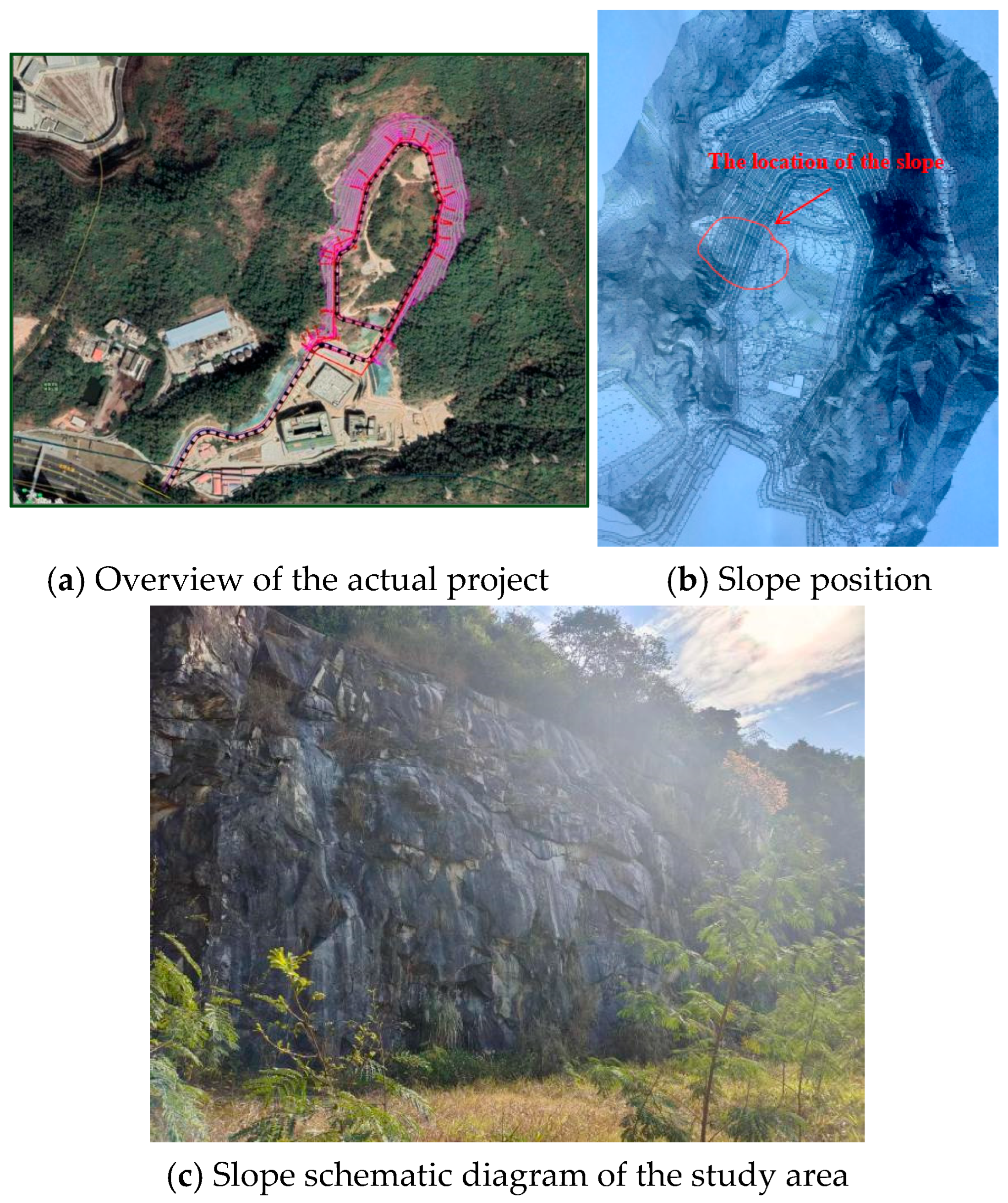


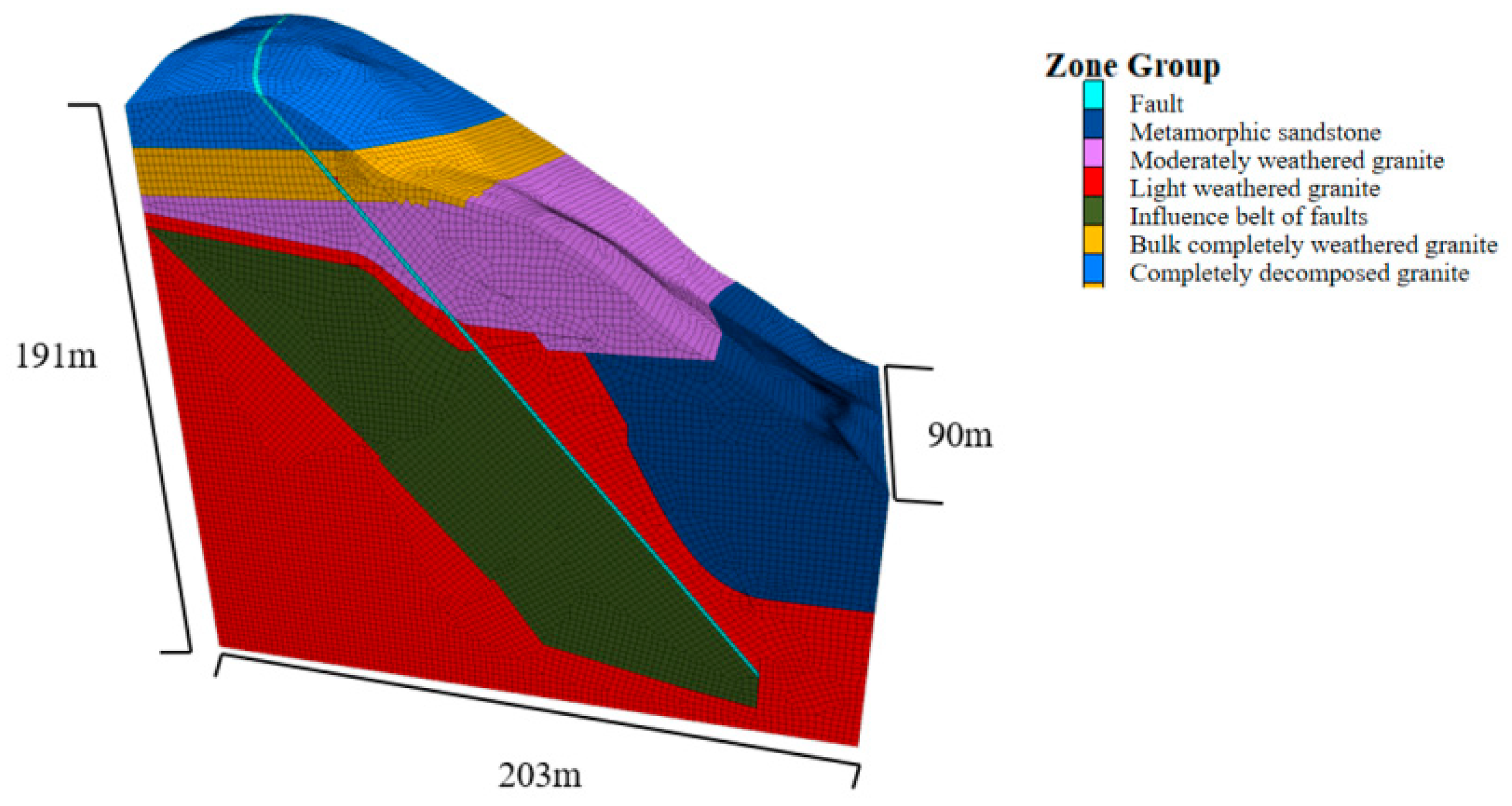

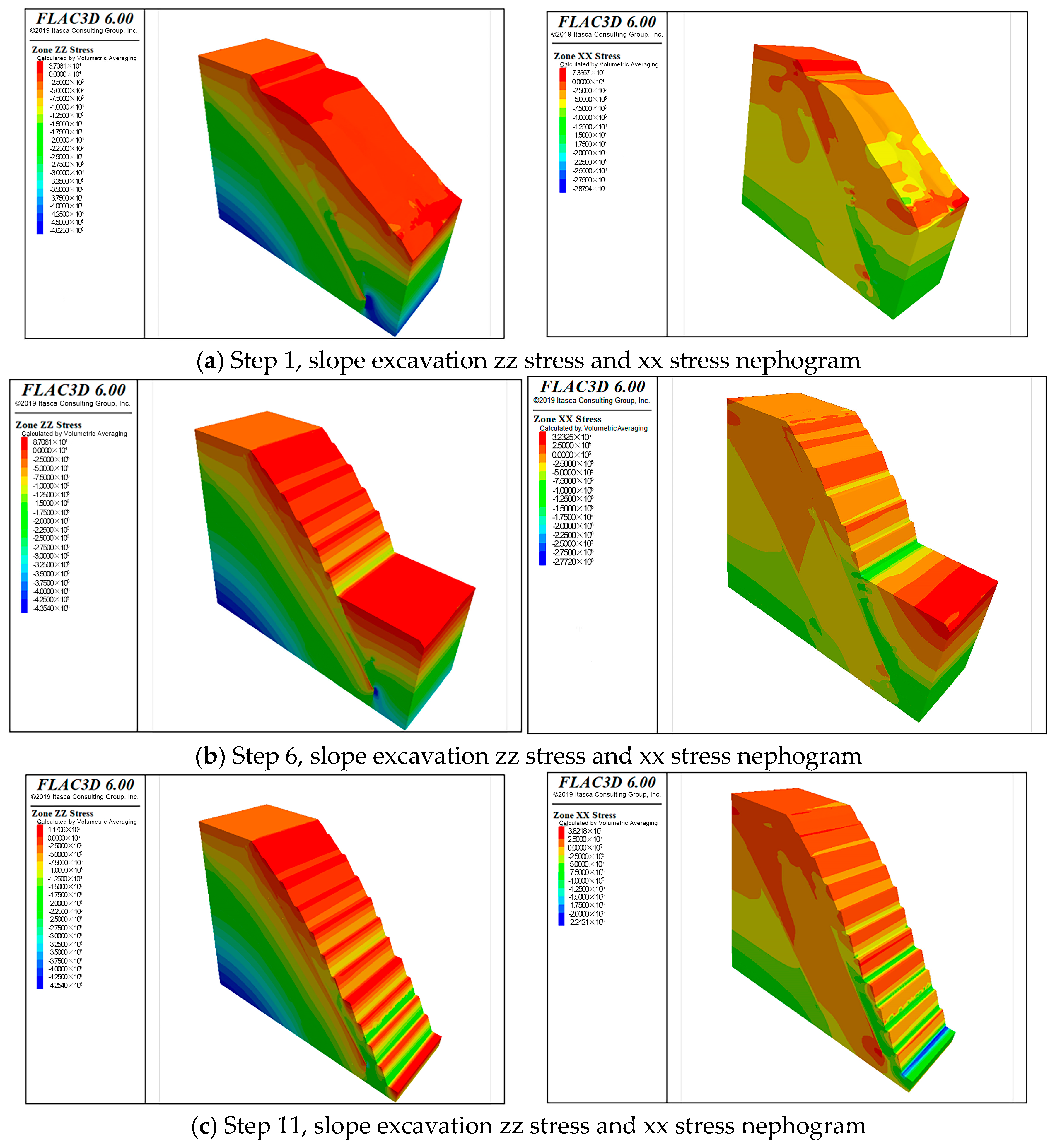
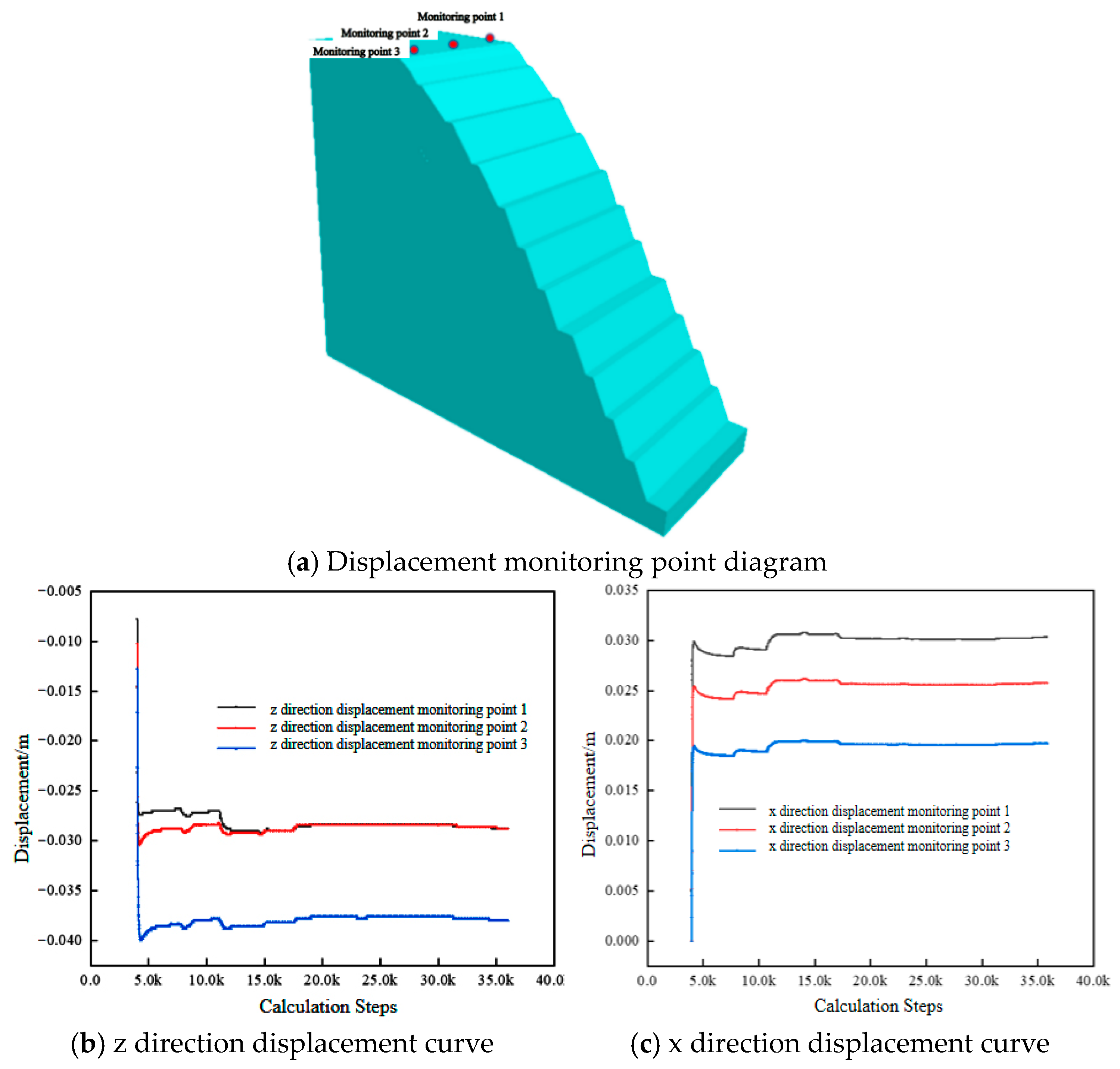
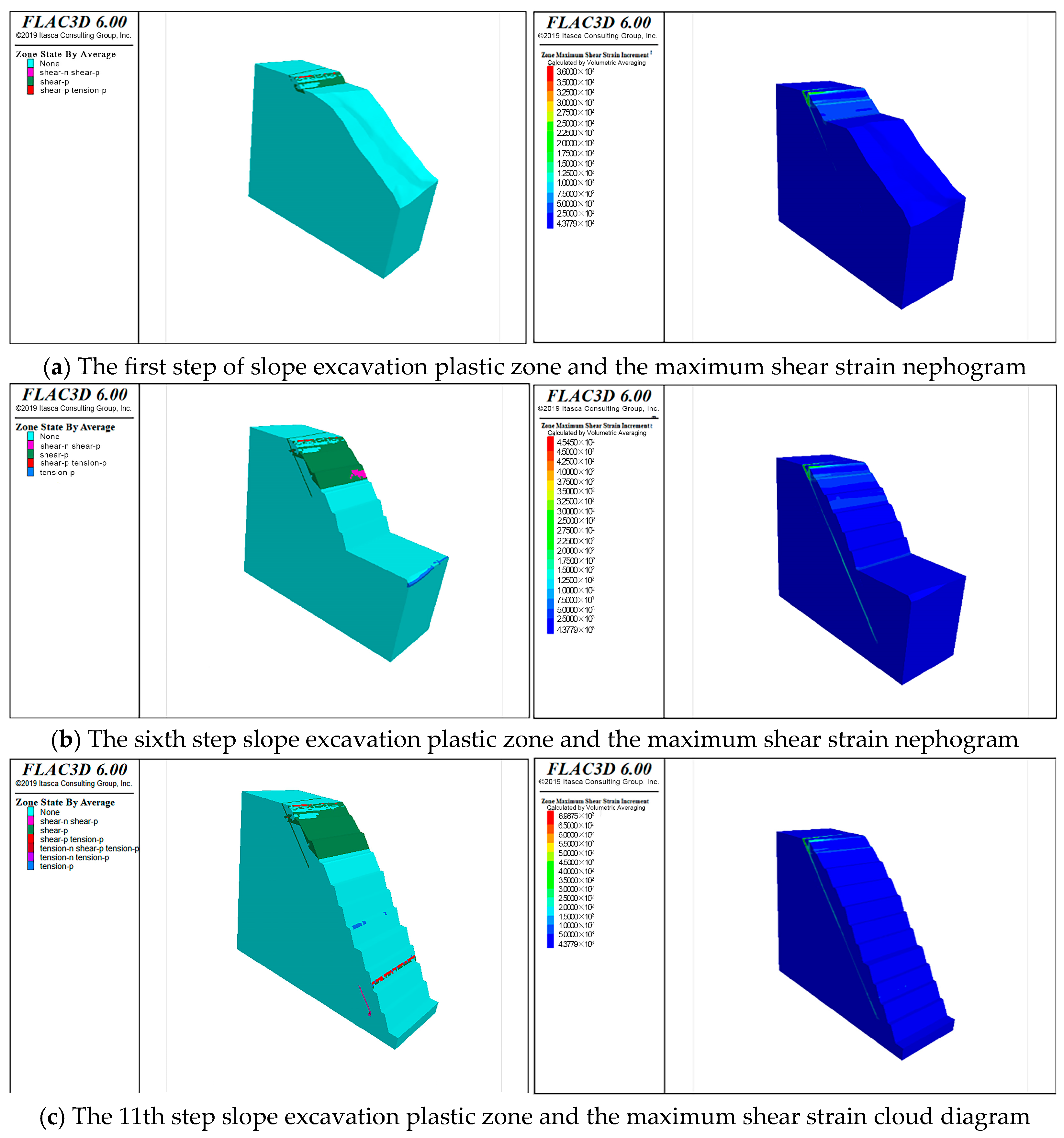

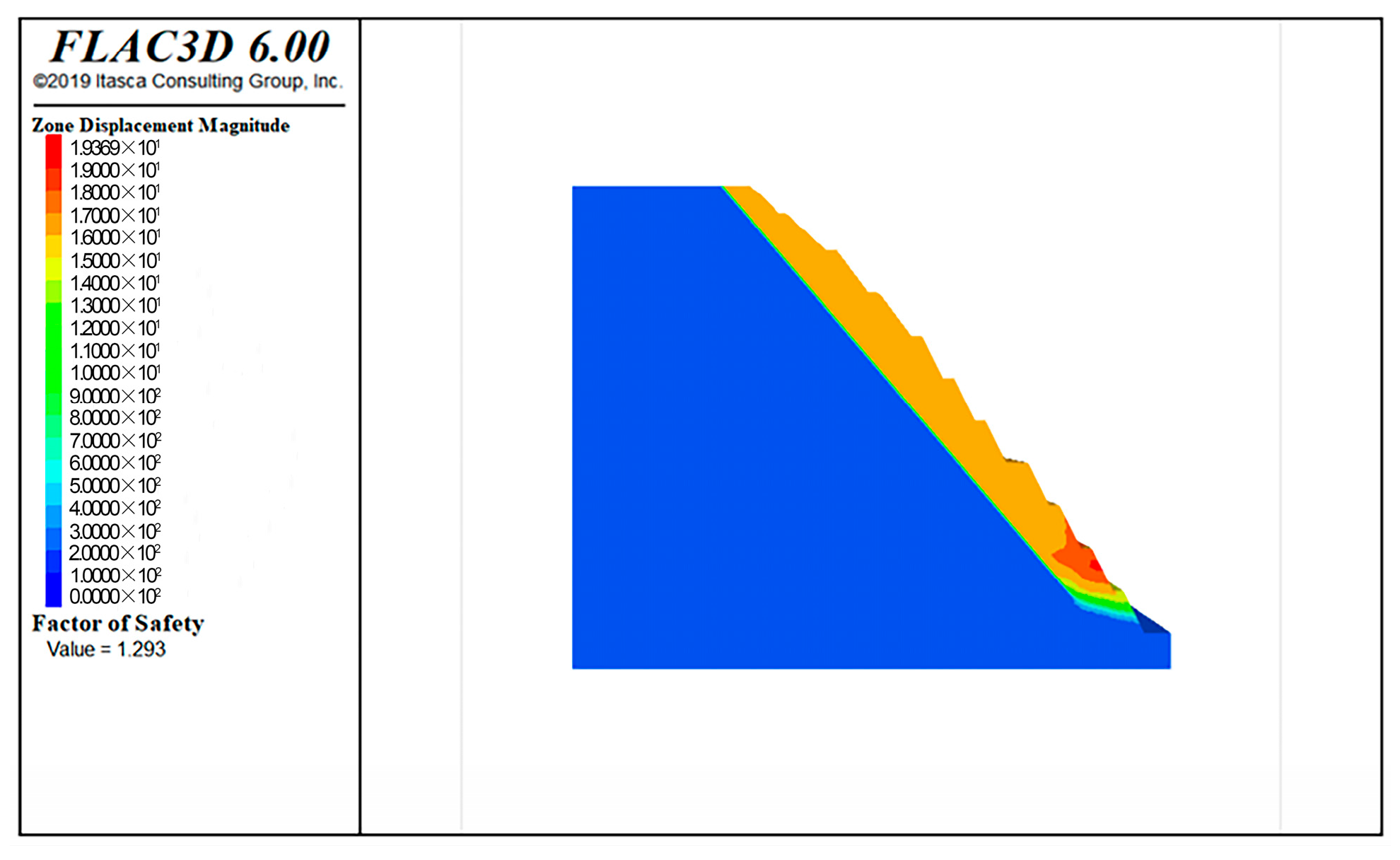
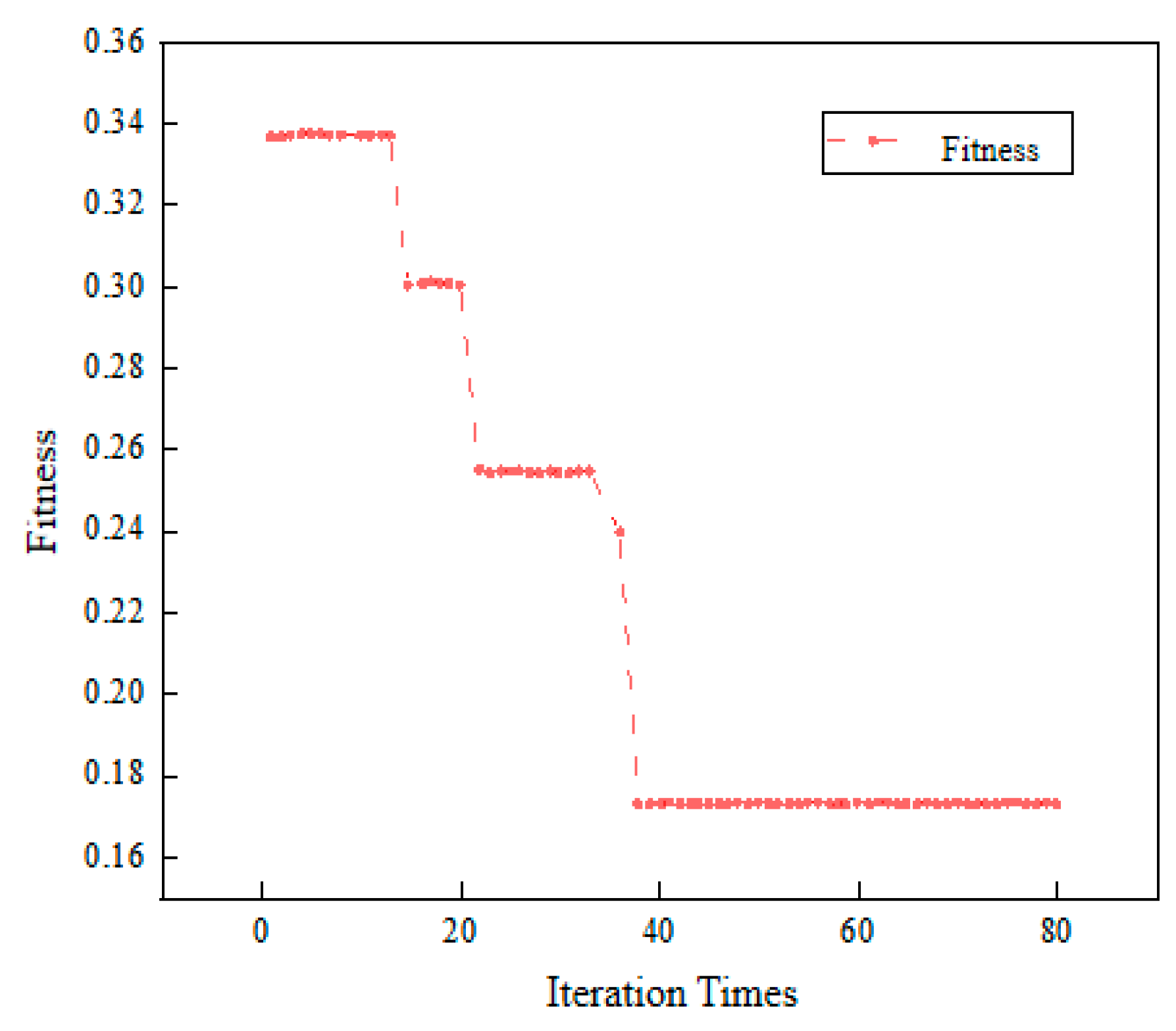
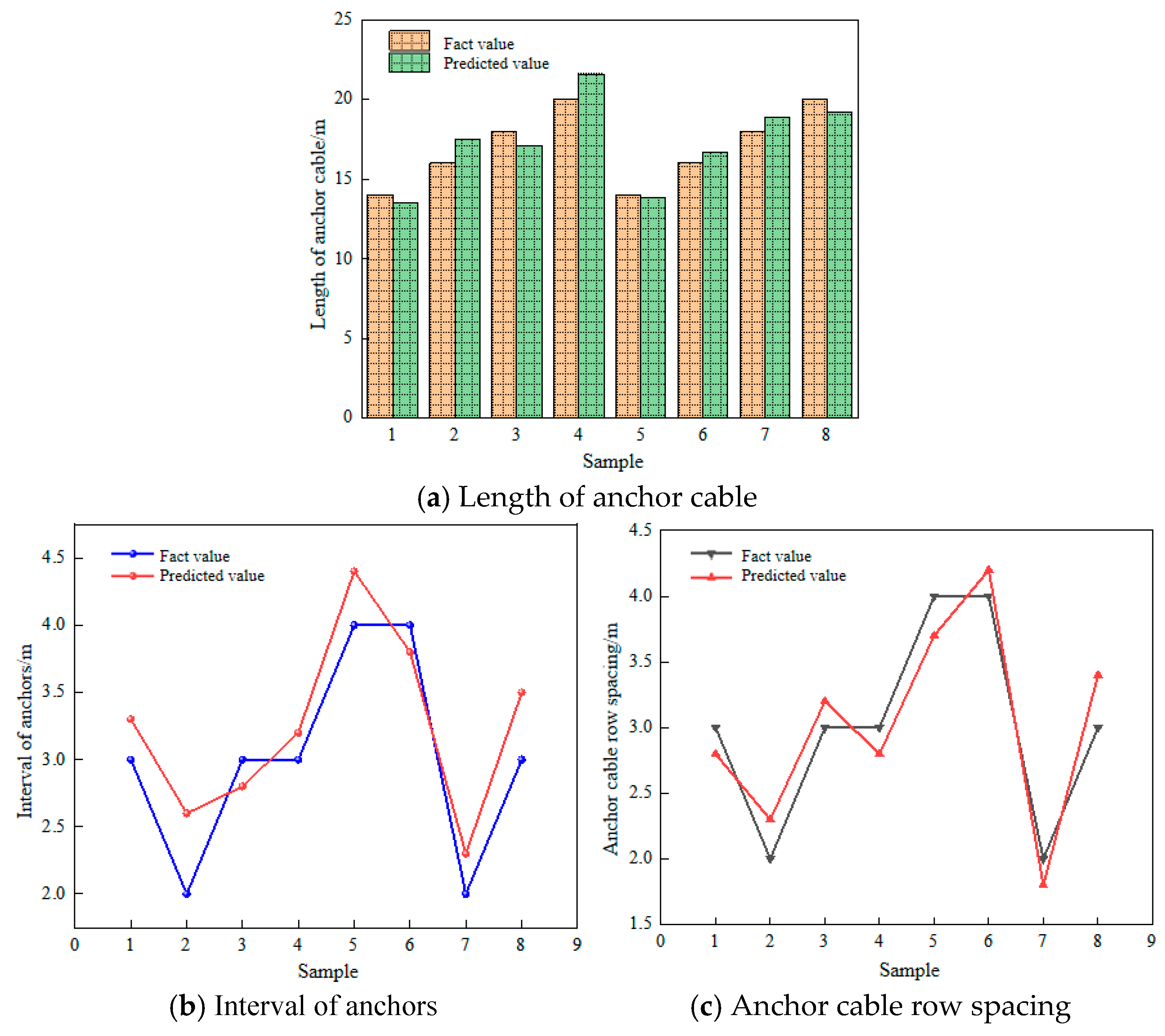
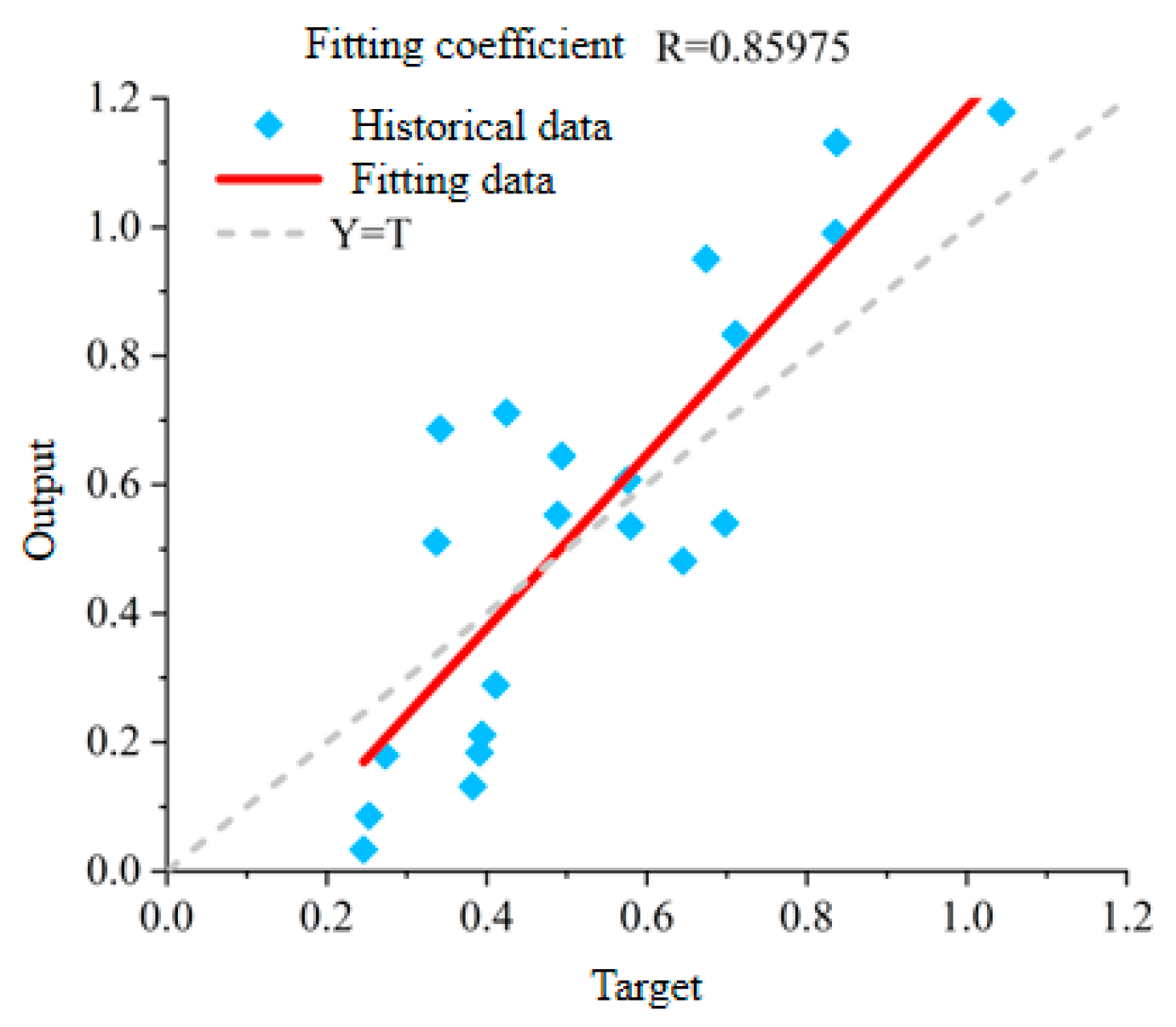

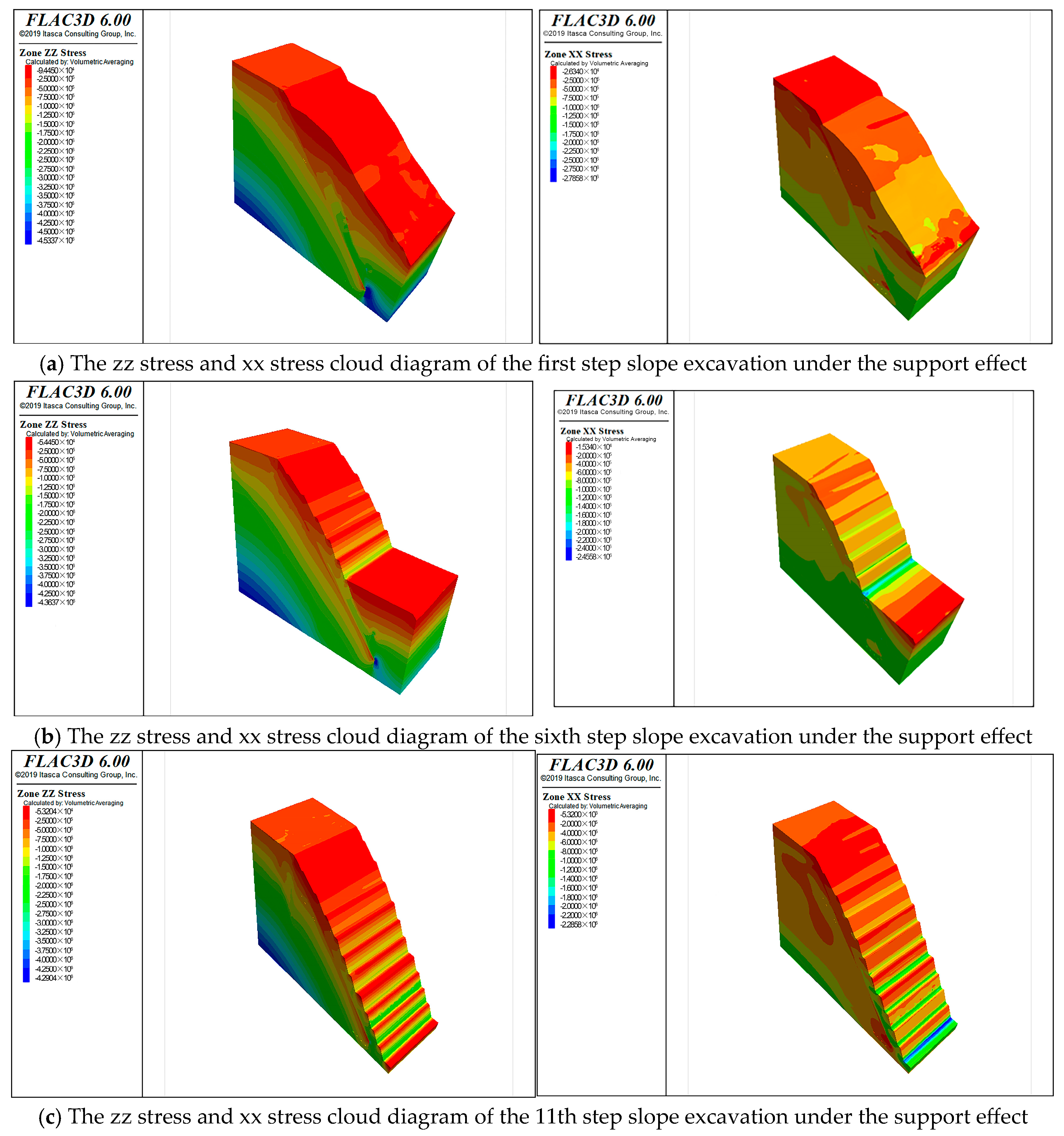


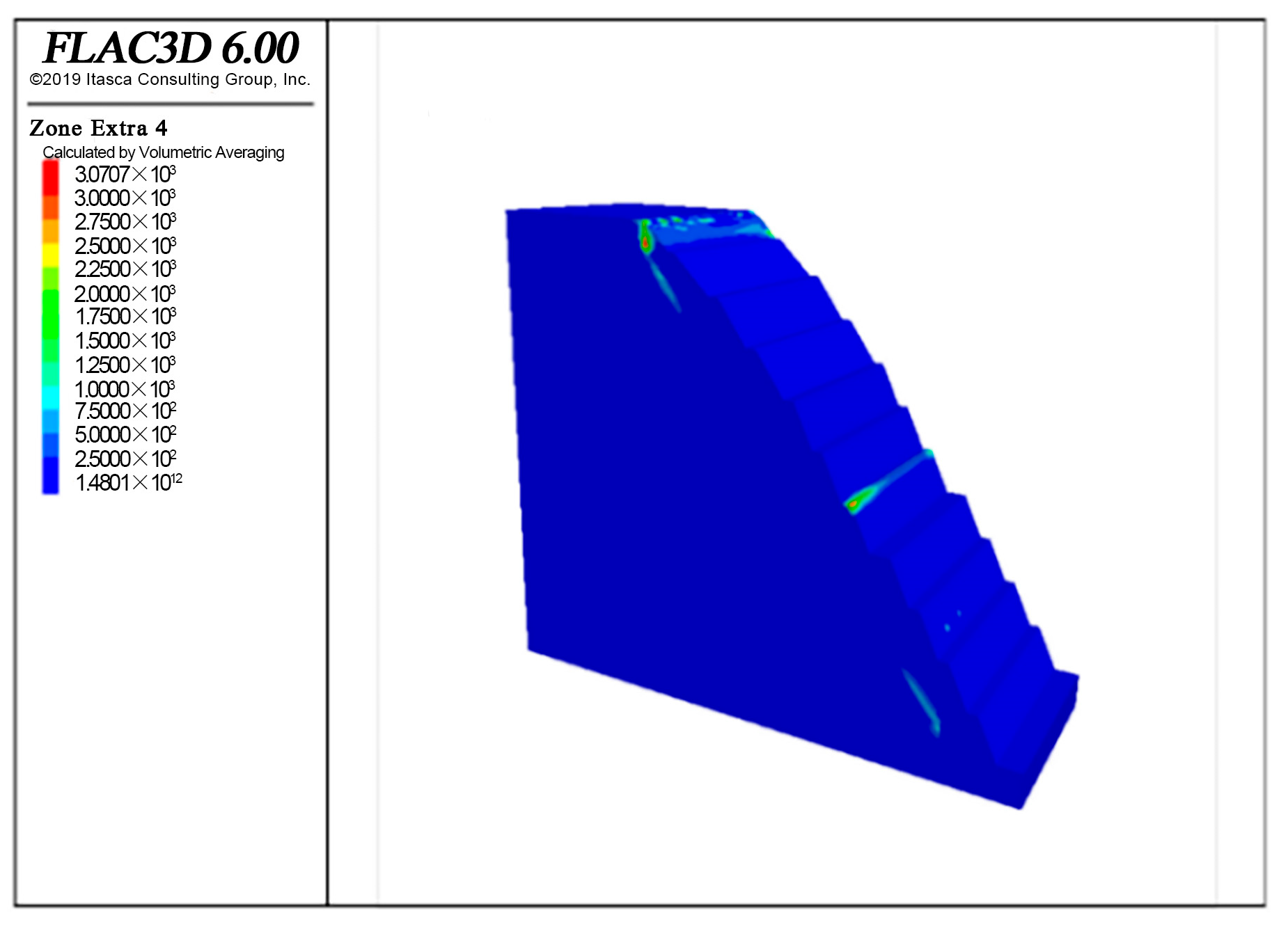
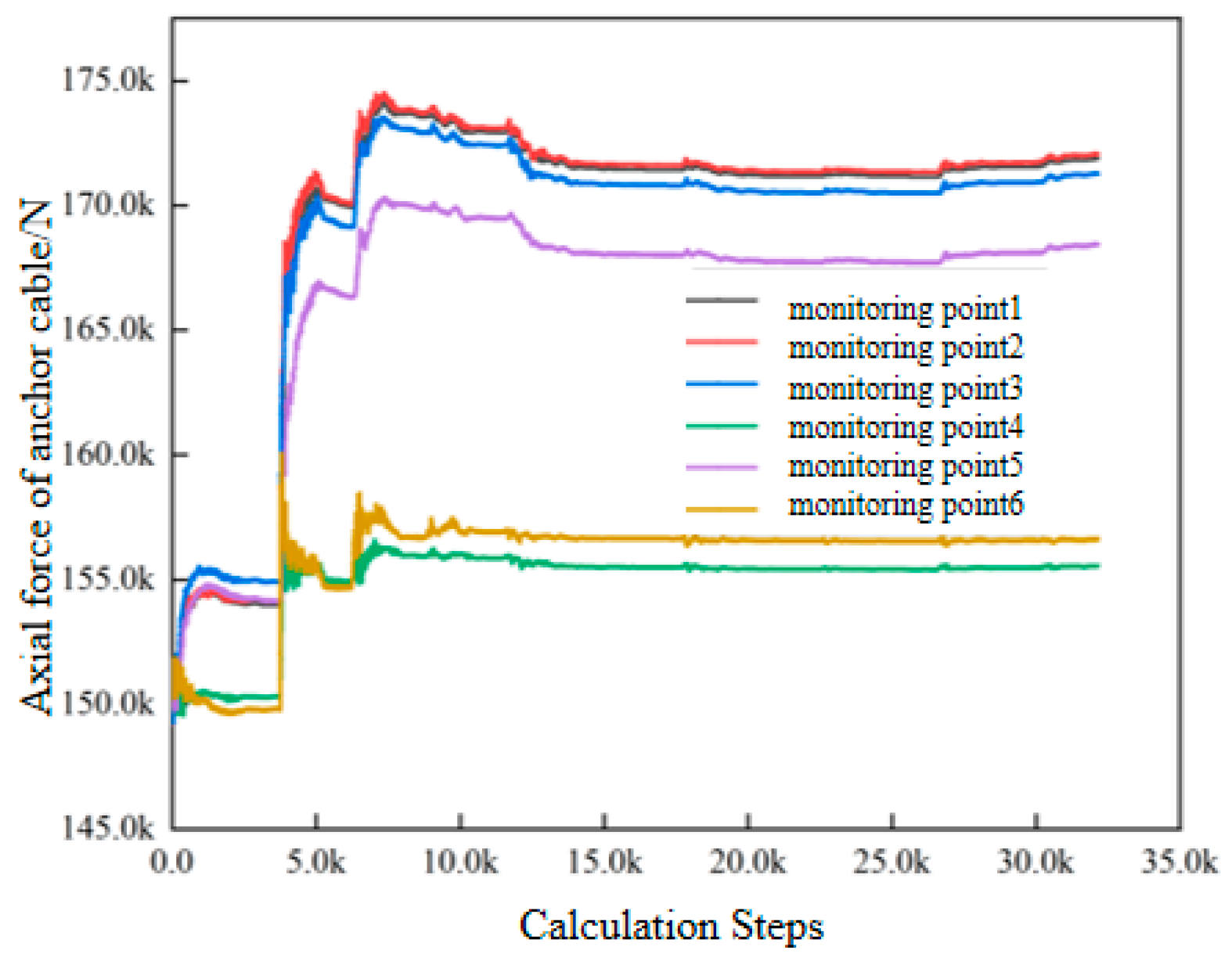
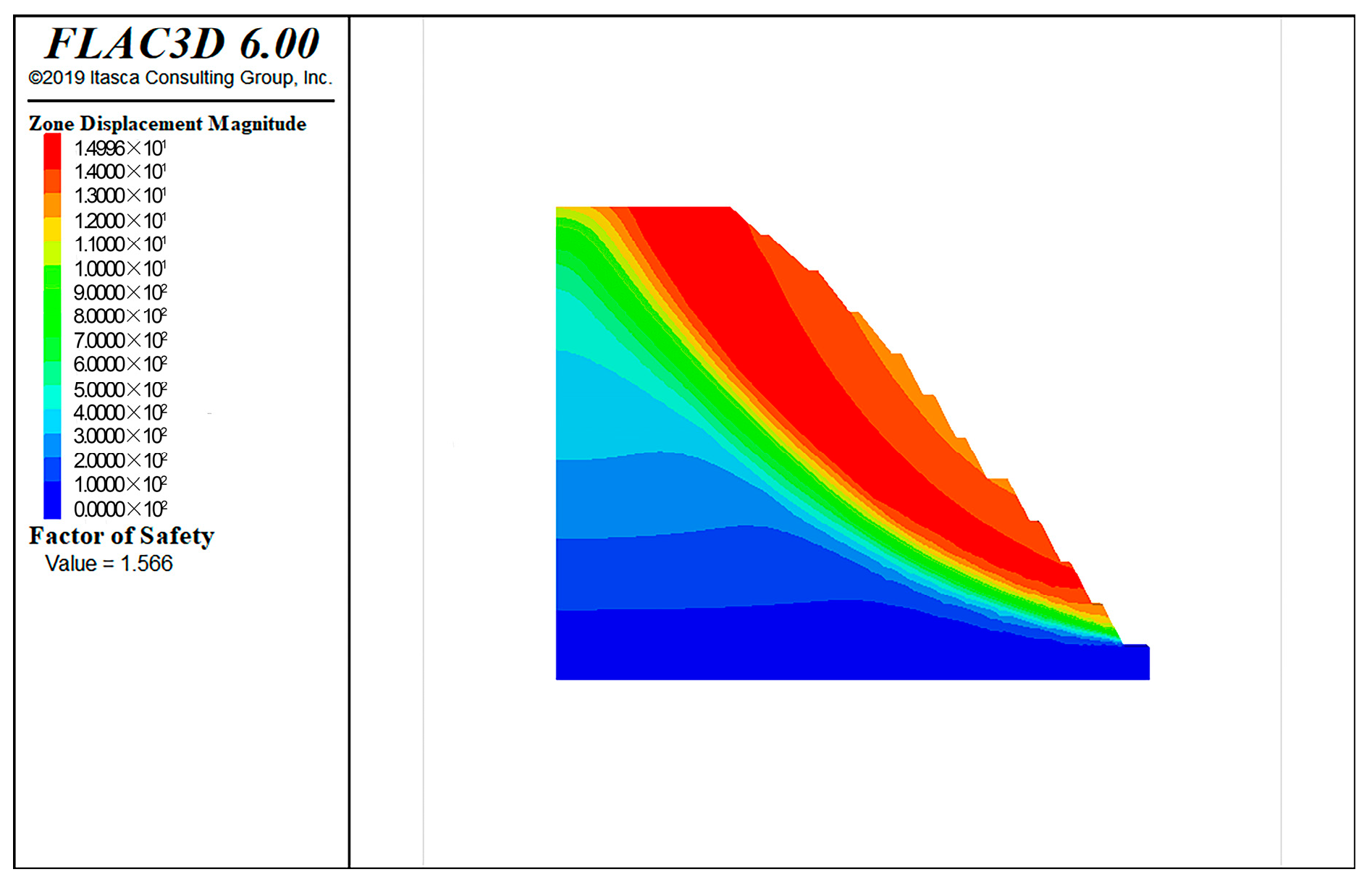
| Type of Test | Test Conditions | Loading Conditions | Specimen Specification (mm) |
|---|---|---|---|
| Uniaxial Compression Test | Natural specimen | Loading by displacement 0.005 mm/s | φ50 × 100 |
| Direct Shear Test | Natural specimen | The loading is divided into 5 stages: 2.6, 3.9, 6.2, 8.3, 10.5 M Pa, respectively | 50 × 50 |
| Rock Classification | Elastic Modulus/GPa | Poisson Ratio | Force of Cohesion/MPa | Angle of Friction (°) | Volumetric Weight kN/m3 |
|---|---|---|---|---|---|
| Light weathered granite | 63.4 | 0.23 | 10.1 | 50 | 27.3 |
| Metamorphic sandstone | 61.6 | 0.23 | 9.5 | 47 | 26.7 |
| Influence belt of faults | 29.8 | 0.25 | 2.7 | 49 | 23.5 |
| Moderately weathered granite | 37.8 | 0.24 | 3.4 | 55 | 23.5 |
| Completely decomposed granite | 3.6 | 0.33 | 1.1 | 30 | 17.5 |
| Strongly weathered massive granite | 8.5 | 0.32 | 1.35 | 35 | 20.5 |
| Samples | Displacement (m) | Dissipated Energy (J/m3) | Factor of Safety | Length of Anchor Cable/m | Interval of Anchors/m | Anchor Cable Row Spacing/m |
|---|---|---|---|---|---|---|
| 1 | 0.0073 | 4224 | 1.43 | 14 | 3 | 3 |
| 2 | 0.0056 | 3465 | 1.47 | 16 | 2 | 3 |
| 3 | 0.0041 | 3137 | 1.55 | 18 | 3 | 3 |
| 4 | 0.0031 | 2658 | 1.63 | 20 | 3 | 2 |
| 5 | 0.0079 | 4622 | 1.37 | 14 | 4 | 4 |
| 6 | 0.0065 | 4223 | 1.46 | 16 | 4 | 4 |
| 7 | 0.0037 | 3012 | 1.58 | 18 | 2 | 3 |
| 8 | 0.0026 | 2967 | 1.62 | 20 | 3 | 3 |
| Test Index | Result |
|---|---|
| R2 | 0.932 |
| RMSE | 0.563 |
| MAPE | 2.36% |
| MAE | 0.3169 |
| Length of Anchor Cable/m | Interval of Anchors/m | Anchor Cable Row Spacing/m | |
|---|---|---|---|
| Support parameters | 18.4 | 2.6 | 3.2 |
| Elastic Modulus/Gpa | Poisson Ratio | Length of Anchor Cable/m | yield Strength/MPa |
|---|---|---|---|
| 200 | 0.2 | 18.5 | 400 |
| Elastic Modulus/Gpa | Poisson Ratio | Cross-Section Area/m2 | Y-Axis Moment of Inertia/m4 | Z-Axis Moment of Inertia/m4 | Polar Moment of Inertia/m4 |
|---|---|---|---|---|---|
| 24 Gpa | 0.2 | 0.6 | 6.75 × 10−4 | 6.75 × 10−4 | 1.35 × 10−3 |
Disclaimer/Publisher’s Note: The statements, opinions and data contained in all publications are solely those of the individual author(s) and contributor(s) and not of MDPI and/or the editor(s). MDPI and/or the editor(s) disclaim responsibility for any injury to people or property resulting from any ideas, methods, instructions or products referred to in the content. |
© 2025 by the authors. Licensee MDPI, Basel, Switzerland. This article is an open access article distributed under the terms and conditions of the Creative Commons Attribution (CC BY) license (https://creativecommons.org/licenses/by/4.0/).
Share and Cite
Zhang, Y.; Wang, X.; Zhang, J.; Chen, X.; Wu, H.; Chen, Y. Research on Slope Excavation Stability Based on PSO-BP Reinforcement Optimization Algorithm. Appl. Sci. 2025, 15, 11726. https://doi.org/10.3390/app152111726
Zhang Y, Wang X, Zhang J, Chen X, Wu H, Chen Y. Research on Slope Excavation Stability Based on PSO-BP Reinforcement Optimization Algorithm. Applied Sciences. 2025; 15(21):11726. https://doi.org/10.3390/app152111726
Chicago/Turabian StyleZhang, Yu, Xuan Wang, Jiasheng Zhang, Xiaobin Chen, Honggang Wu, and Yingrun Chen. 2025. "Research on Slope Excavation Stability Based on PSO-BP Reinforcement Optimization Algorithm" Applied Sciences 15, no. 21: 11726. https://doi.org/10.3390/app152111726
APA StyleZhang, Y., Wang, X., Zhang, J., Chen, X., Wu, H., & Chen, Y. (2025). Research on Slope Excavation Stability Based on PSO-BP Reinforcement Optimization Algorithm. Applied Sciences, 15(21), 11726. https://doi.org/10.3390/app152111726





